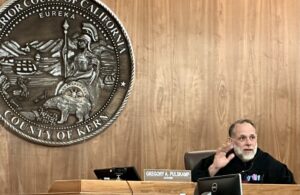If anyone thought a recent court order mandating 40% of the Kern River’s flow remain in the river for fish was the end of the story, think again.
Agricultural water districts are striking back.
Not at the fish.
But at what they say is an historic water heist by the City of Bakersfield.
On Tuesday, a coalition of ag districts filed a motion to stay and motion for reconsideration of Kern County Superior Court Judge Gregory Pulskamp’s injunction and implementation order requiring water in the river. The group, including Kern Delta Water District, Kern County Water Agency and the North Kern, Buena Vista and Rosedale-Rio Bravo water storage districts contend, among other things, that the implementation order was rushed by them not affording them due process.
Ag districts are furious the city is using the new fish-flow order to take an additional 180 cubic feet per second for itself that they say is above the city’s existing rights. Beyond that, the city is taking that 180 cfs at the head of the line among rights holders.
“It’s the biggest water heist on the river in the last 100 years,” said Steve Teglia, General Manager of the Kern Delta Water District, which until recently enjoyed the first and most generous right to Kern River water.
The 180 cfs being claimed by the city will increase its Kern River supplies five times over what the city has taken and used each day in mid-November over the past 10 years, according to an email from Dave Hampton, General Manager of the North Kern Water Storage District.
“In claiming this right to 180 cfs, Bakersfield is no different than someone who cuts to the front of a rationing line,” Hampton wrote. “The judge’s order is about establishing an interim flow regime to support fish, not a handout to Bakersfield to secure more water for municipal purposes while leaving all the other water users literally hanging out to dry.”
For its part, the city, which operates the system of weirs that divert water from the river, says it’s simply complying with the injunction and subsequent implementation order issued by Pulskamp as part of an ongoing lawsuit brought against Bakersfield by several public interest groups.

“We presented evidence to the court of the City’s need and demand for water which is and which has been 130,000 acre feet per year and 180 cfs per day,” wrote the city’s attorney Colin Pearce in a text message. “The court accepted that evidence so it is now confirmed in the court’s order.”
When asked if the 180 cfs is in addition to the city’s existing rights, purchased in 1976, Pearces wrote, “The City is still taking water under historic rights which are separate from the city’s domestic supply.”
As for how the city is able to take its cut ahead of other rights holders, Pearce wrote that California Water Code and Pulskamp both agree that domestic use is the highest priority use for water.
“Since the judge ruled that the injunction and allocation of water should not reduce the City’s supply, the City necessarily is now ahead of agricultural uses for its needs,” he wrote.
Ag districts say that interpretation simply can’t be extrapolated from the judge’s injunction.
“The injunction did not allow a new right,” Teglia said.
He said Pulskamp even notes in his injunction that the city’s existing Kern River rights have never failed to provide for all its demands and that leaving water in the river for fish flows would have the added benefit of replenishing groundwater, relied on by Bakersfield for its drinking needs.
“…in the ‘average year,’ the river provides over five times Defendant’s current use,” Pulskamp’s injunction states. “Accordingly, the present action (requiring water for fish) does not appear to threaten the domestic supply.”
“No one is arguing about the city’s demands,” Teglia said. “That’s all a smokescreen. Where in the judge’s order does it insert a new right?”
Teglia also noted that Pulskamp’s injunction states it applies to all rights holders: “This court has a duty to uphold the law and has no option to exempt entities from compliance, even if compliance is burdensome,” it states.
The injunction was issued on Oct. 30 prohibiting Bakersfield from taking so much water out of the river that it would harm fish. Pulskamp didn’t say how much water should stay in the river, leaving that to the city and plaintiffs to figure out.
They agreed that 40% of the river’s flow would suffice on an interim basis until studies can be conducted to determine exactly how much water fish need to survive and Pulskamp signed off on that order Nov. 14.
In that order, a paragraph gives an example of how the flows would be parsed out under the 40% regime:
“By way of example, using the average annual Kern River flow as stated in the Ruling on page 14 of 726,000 acre-feet per year, which converts to approximately 1,000 cfs average daily flow, Bakersfield will multiply that amount by 40% to arrive at 400 cfs to be left in the river for interim fish flows.
Bakersfield will allocate 180 cfs of the 1000 cfs flow for the City’s demands, leaving a balance of 820 cfs. 400 cfs will be left in the river for fish flows, and the remaining 420 cfs of flow (1,000 cfs minus 180 cfs and 400 cfs) would be available for diversion by the Real Parties in Interest.”
Under that order the city has begun issuing daily “interim flow regime” sheets showing how water is divvied up per this new protocol, giving itself the first 180 cfs after subtracting fish flows.

The plaintiffs, including local advocacy group Bring Back the Kern and several other public interest groups, agreed to that wording because “the city wanted to be confident in their supply which they determined to be about 180 cfs,” said attorney Adam Keats.
As for concerns by the ag districts that the city is cutting into their rights, Keats said, “They just don’t get it. None of that is relevant to what we’re talking about.”
He said the Public Trust Doctrine, California Fish and Game Code 5937 and Article 10 of the California constitution all say, essentially, that people and the environment come first in the water line.
Judge Pulskamp’s injunction recognizes that and didn’t get into the rights debate, Keats said.
“The focus of his injunction was entirely on the fish flows. There’s plenty of water between the city and the fish. Look, someone’s getting a haircut, but it’s not going to be the city or the fish.”
Share this:
- Click to share on Facebook (Opens in new window)
- Click to share on Twitter (Opens in new window)
- Click to share on LinkedIn (Opens in new window)
- Click to share on Reddit (Opens in new window)
- Click to share on Tumblr (Opens in new window)
- Click to share on Pinterest (Opens in new window)
- Click to share on Pocket (Opens in new window)
- Click to share on Telegram (Opens in new window)
- Click to share on WhatsApp (Opens in new window)
- Click to print (Opens in new window)








You must be logged in to post a comment.